How to create an easy sustainable garden
In 2022, a sustainable garden is increasingly important.
We urban gardeners manage a substantial chunk of the outdoor space in any town or city. There are 30 million gardeners in the UK alone. So what we do impacts our air quality, the survival of wildlife and other environmental issues.
A sustainable garden is also usually cheaper, so when budgets are tight, it is really worth considering sustainability.
Sustainable garden checklist
1) Buy plants sold in recyclable pots. Re-use plastic pots.
2) Try to avoid other one-off plastics… buy bulbs or potatoes in paper bags or compost in re-usable bags
3) Save water. Install large water butts. Don’t water your lawn. Think about how much water a plant will need when you buy it.
4) Make your own compost
5) When buying commercial compost, choose peat-free
6) Re-use or recycle larger items such as tools and furniture. Try eBay, Freecycle, Freegle and charity shops
7) When buying new garden furniture, look for FSC certification and check origins
8) Use biodegradable wooden plant labels
9) Use wool or jute twine ties not plastic
10) Use metal plant supports or make your own from birch twigs
11) Use permeable paving for paths, terraces and parking areas. Limit hard landscaping generally.
12) Plant a tree. Or don’t cut one down. Trees are excellent carbon sinks.
13) Use environmentally friendly pest controls or minimise pest control
14) Plant flowers that are good for pollinators
15) Have hedges instead of fences – hedges offer wildlife habitats and counter air pollution
16) Add bat boxes and bug hotels to the garden, plus twigs and leaves in piles at the backs of borders
Click here if you’d rather watch a video than read a post.
And an eco-friendly garden saves you money
I’ve noticed that I am often most eco-friendly in the garden when I’m trying to save money.
If it’s easy to garden sustainably and it saves you money, it’s more likely to become a habit. There’s more about saving money on gardening here.
And it’s only by changing habits, that we can really have a sustainable garden.
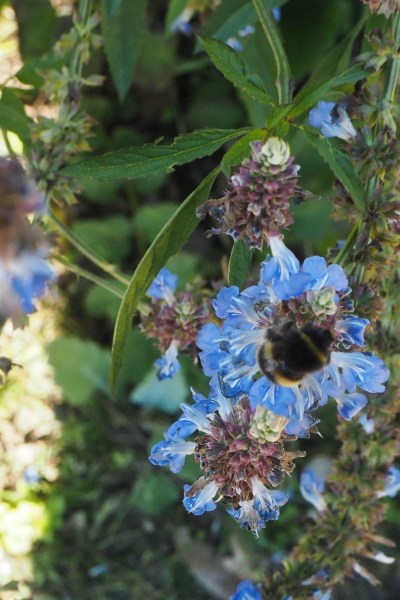
A sustainable garden is wildlife friendly, too.
There are affiliate links to Amazon in this post, see disclosure.
Sustainable gardens and plastic pots
Plants sold in black plastic pots can’t go into our council recycling bins because the automatic sorters can’t pick up the black plastic. So they’ll go into landfill and take centuries to break down. Some councils will take them at the recycling centres, so you can ask.
Several plant growers are experimenting with using recyclable pots. Locally to me, Edible Culture have devised a biodegradable Posipot. And there are other recyclable pots available now. So look for garden centres selling plants in recyclable pots.
And re-use the pots you already have. I have about sixteen years’ worth of plastic plant pots. I really don’t need to buy any more. And I certainly don’t need to fiddle around making seedling pots out of newspaper.
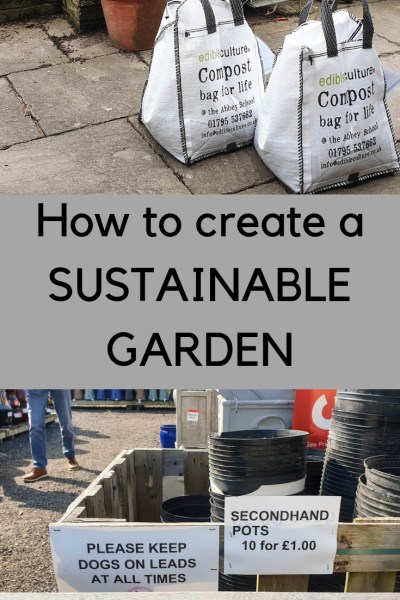
Local nurseries Edible Culture and Maytree Nurseries have great sustainable initiatives. Look out for similar initiatives near you.
If you don’t have lots of plastic pots, your friends probably do. If you belong to a gardening, book or any other club, you could try a plastic pot swap one day. Or see if your local garden centre will recycle them like Maytree Nursery near me.
Other single use plastics in the garden
Plastic bags with compost, bulbs or plants are also single-use plastics. Maytree Nurseries is also reducing this by selling potatoes in paper bags, rather than pre-packed in plastic. And Edible Culture sell their compost in re-usable bags – you pay £8 for the initial bag of compost, but only £6.50 when you take the bag back for a re-fill.
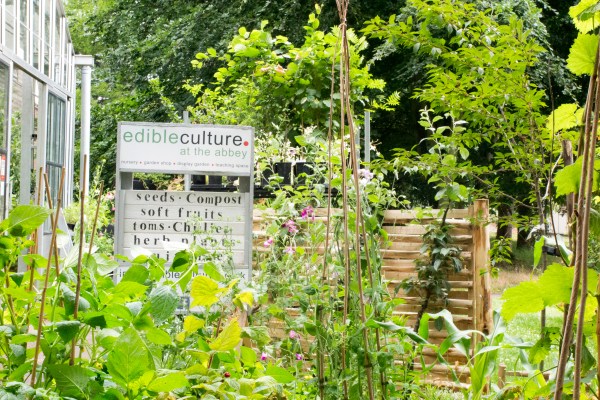
Edible Culture in Faversham has invented the Posipot and is also selling compost in re-usable bags.
If you can’t find nurseries or garden centres doing this kind of thing near you, you could suggest it.
Plastic garden netting to keep birds off your crops is another issue, although it can be re-used more than once.
Several friends of mine poke birch twigs in around seedlings to protect them from hungry pigeons. I’ve done this successfully myself and am currently trialling two beds – one protected with birch twigs and one with netting.
I can’t give you an explanation of this, but I do know that it can work.
Save water in the garden
See my post on easy, effective water saving tips for the garden.
Water butts are not a magic solution to sustainability, because they dry out quickly in droughts. But they help. Buy the largest you can fit in.
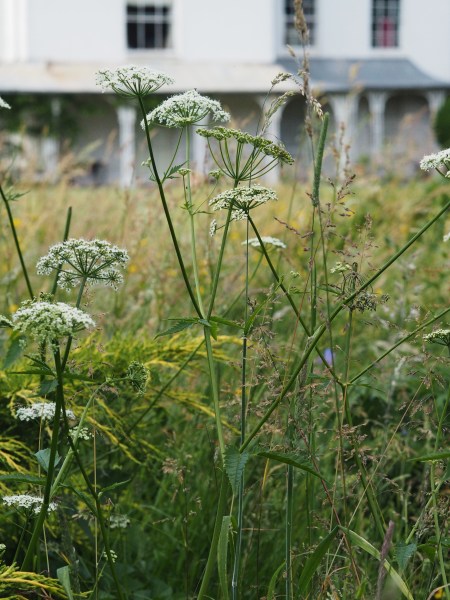
You don’t need to water your lawn – this is a mix of standard lawn and meadow grass and it’s never watered.
And let your lawn go brown. It is not dying, only dormant and will recover. Only newly planted or laid lawns need regular watering in their first summer.
Other plants that really need watering include annuals, vegetables, plants in pots and newly planted shrubs and perennials.
But ideally choose plants that grow well in your climate without too much extra care needed. If your rainfall is regularly low, there’s good advice here on how to create a dry garden.
The RHS now suggest that when you buy a plant, consider its watering requirements and ask yourself ‘can we afford the watering?’
Make your own compost
Making compost saves you the time and petrol you waste taking garden clippings to the local tip. Compost also returns nutrients to the soil.
But, once again, it’s not the solution to all your compost needs. Personally I find it difficult to make enough compost for my own needs in my middle-sized garden.
The most important thing to understand about making compost is that there are two methods – the fast ‘hot’ method and the slow, easy way.
Personally I do the slow, easy way. But it means that I only make about one third of the compost I need for the garden, and have to buy more.
See here for the really easy way to make your own compost.
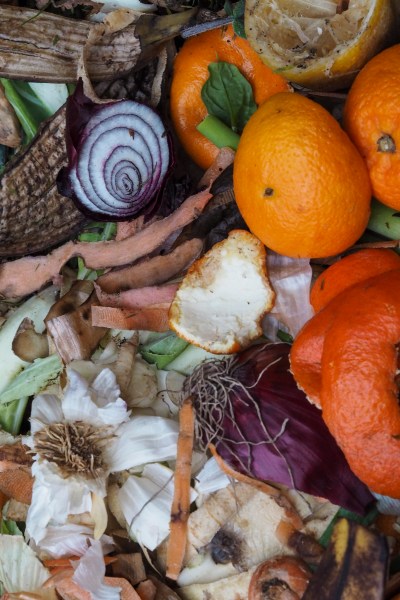
Compost raw fruit and veg peelings, garden and lawn clippings, and even some newspaper and twiggy matter.
If you have a small garden and your council does a green waste pick-up, then that is good. We find our garden generates too much waste and the bin isn’t large enough.
What to put in the compost
We use twigs for kindling, logs for the fire and leaves go on the compost. But if you have a lot of bracken-type clippings that take a long time to compost down, you may prefer to burn them in a bonfire. Chop them up to make them compost down faster.
Australian gardening broadcaster and rare plant specialist Stephen Ryan has an arrangement with his local supermarket. He picks up food that’s gone past its sell-by date. He feeds some to his hens and ducks and composts the rest.
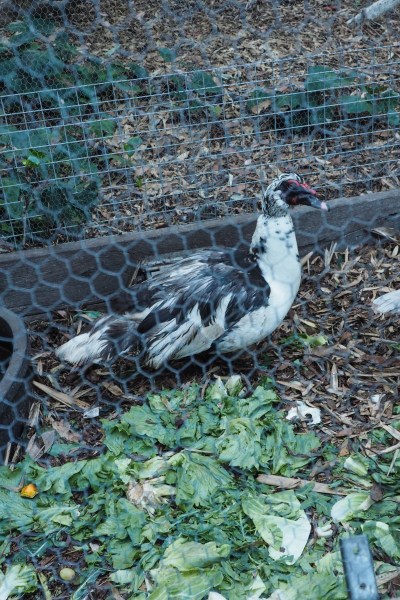
Stephen Ryan’s Muscovy duck enjoying her supermarket bonanza.
Bonfires are not as environmentally-friendly as composting. But they are usually legal in the UK, provided the smoke doesn’t blow across a road.
And bonfire ash is good for the garden – spread it on the beds.
Buy sustainable garden compost -choose peat-free!
The RHS says that gardeners should never use peat-based composts. The damage to the environment is too great.
I was given a bag of Westland’s New Horizon Bio3 peat-free compost to try. I’ve been growing seedlings in it, alongside trays of seedlings grown in ordinary peat-based compost. Find stockists of New Horizon Bio3 here.
So far, I’ve had reasonably good germination. Other excellent peat-free seed and potting composts include Melcourt Sylvagrow and Carbon Gold Biochar. These were also sent free for me to review.
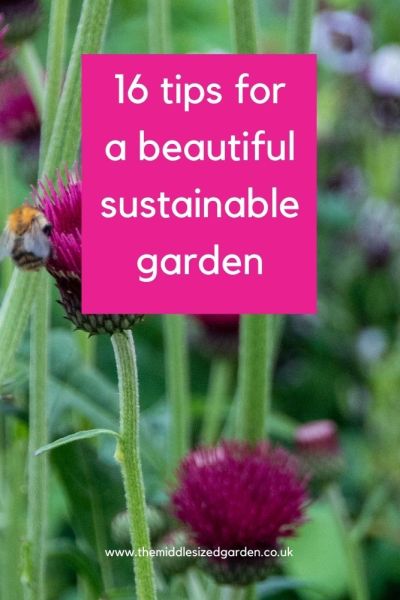
Some people have reported poor germination when growing from seed in peat-free composts and that manufacturers seem to keep changing the composition. Others say that it’s just a question of getting used to using the new composts. And it’s important to note that there are lots of reasons for poor germination of seeds, especially a faulty seed packet.
Sustainable garden furniture – re-use and recycle
Re-use or recycle furniture for the garden. We recycled an old sewing machine table and the four chairs from a depot vente in France. Shall we ignore the extra cost of transporting them?
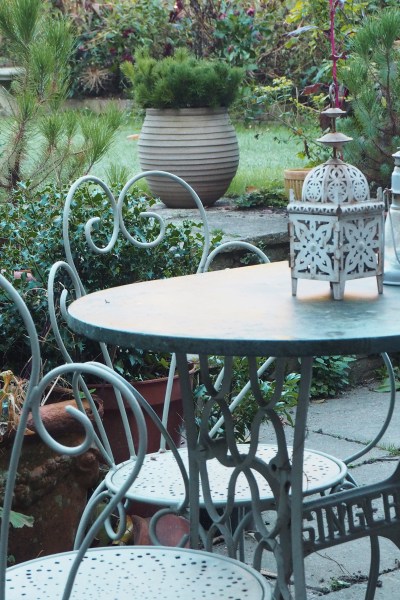
My mother gave me this sewing machine stand in the 1980s and we added a granite top. The four chairs came from a depot vente in France and probably date back to the 1960s.
But there is lots of second-hand garden furniture available. Try Freegle and Ebay, as well as local junk shops. Some charities also recycle furniture – try Emmaus and or Google ‘charity furniture shop.’
Friends have also used second-hand metal office furniture in their gardens. There are some more ideas in this post on 15 ways to transform your garden with upcycled junk.
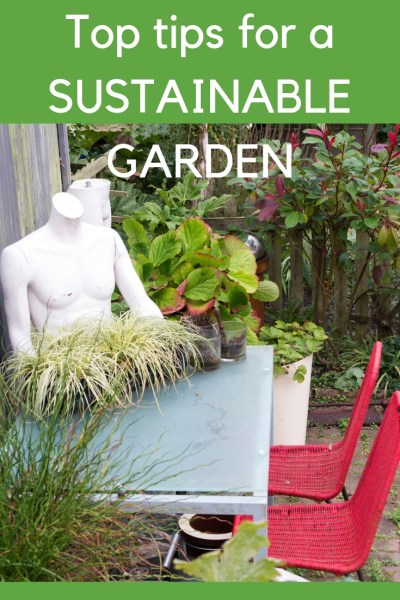
This is a second-hand office desk, re-imagined for use as a garden table.
Apply the ‘re-use or recycle’ principle to everything in the garden. For example, you don’t have to grind up or take away a tree stump. You could keep it in the garden as a design feature and create your own stumpery (see this post.)
Look for sustainable garden credentials
When you buy new wooden garden furniture, look for FSC certified wood. The FSC is the Forestry Stewardship Council. It aims to police illegal logging, deforestation and also poor working practices for people working in the timber industry.
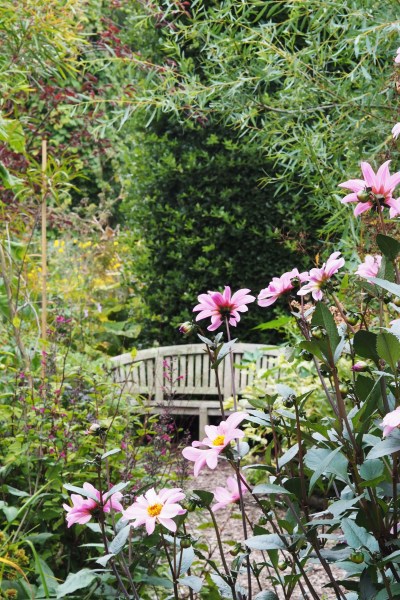
When buying new wood garden furniture, check that it’s made of FSC accredited wood.
Or you can buy garden furniture made from recycled wood or plastic. You can also find furniture made of recycled metals. However, it is worth noting that it’s very difficult to find truly sustainable garden furniture as most will ultimately end up in landfill.
Many sustainable approaches also save you money, so if you’re thinking of a major garden re-vamp, see How to Save Money on Garden Design to give you ideas.
Use biodegradable wooden plant labels
Other small things can make a difference include using biodegradable wooden plant labels instead of the plastic ones. They’re slightly cheaper and I find them easier to write on.
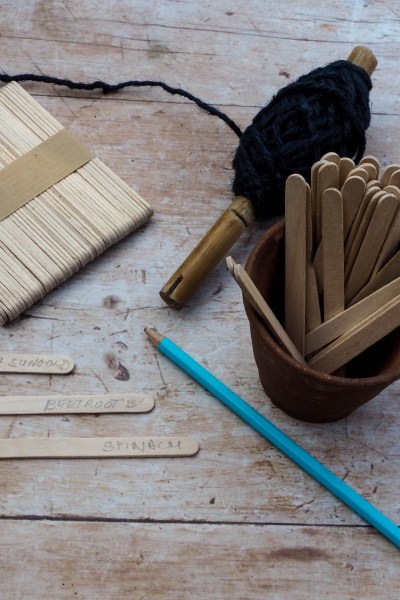
Nutley’s wooden labels and jute twine instead of plastic.
This year I’ve bought Nutleys Wooden Seedling Labels fromAmazon. But I note that I could have bought the slightly larger wooden lollipop sticks even more cheaply.
Sustainable garden ties
Use jute or wool twine. I’ve bought Nutscene garden twine and have been sent Twool wool garden twine for review. Both are good. Jute or wool twine is also less likely to cut into the bark of a tree or shrub as it grows or sways in the wind.
Young trees need something stronger. Use old tights. There are some plastics in tights but at least you’re re-using rather than buying something new. Also it’s only the tights with micro-fibres that are really a problem.
Sustainable garden plant supports
I find that plastic or plastic-covered plant supports often aren’t strong enough. I have bought several sets of steel plant hoops (the ones with two legs and a bent top). They’re great to jam in when a plant is flopping over. A plant crook or cane works well for top-heavy single blooms.
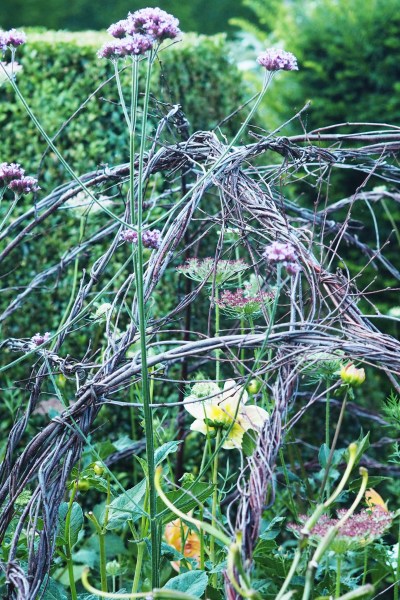
Home-made birch twigs plant supports at Doddington Place Gardens. They’re very easy – I’m not at all handy and I can do them!
I’ve also done a post on the plant supports I make out of birch twig clippings.
Sustainable garden paving
The Society of Garden Designers recently held a conference on sustainable gardening practices. All hard landscaping materials have some negative effect of the environment, so they recommend limiting the use of hard landscaping as much as possible.
Garden designer, Marian Boswell, says that when choosing hard landscaping, you should ask three questions. Firstly, can you re-use what you already have? Secondly, how far will anything you buy have to travel? And thirdly, what will happen to it in 100 years time?
Stone and brick last a long time. Gravel and shingle are mined. How paving is made and where it comes from impacts on its green credentials. There is a listing of eco-friendly pavers on Greenspec.
Other things to look for include pavers made from recycled materials and FSC certified decking.
We used cockle shell mulch for our garden paths. Seashells are an environmentally-friendly option because they’re a by-product of the seafood industry. From a distance it looks like gravel, and after a year, the shells still look good.
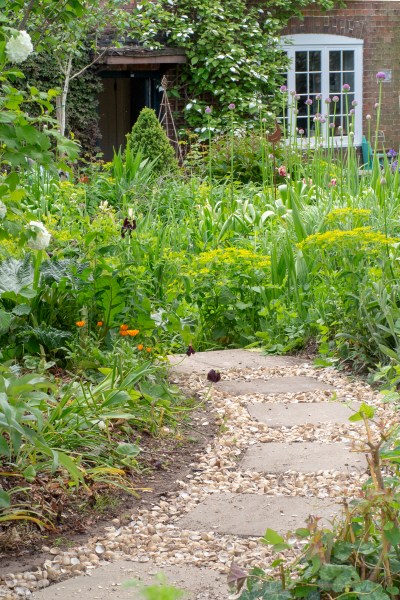
Our garden path is made of cockle shell mulch with concrete pavers inset. Cockle shells are a by-product of the seafood industry. From a distance, it looks like gravel.
One of the most important things for any patio, path or drive way is to ensure run off. Rainwater should be able to soak into the ground around pavers. A solid concrete patio or driveway is contributing to flash flooding in towns and cities.
What about concrete pavers? The concrete industry creates up to 5% of worldwide carbon dioxide emissions.
The manufacture of cement and concrete also accounts for nearly 10% of the worldwide industrial use of water. There is now some use of recycled concrete and some interesting progress towards making its manufacture more sustainable.
But concrete is very long-lasting – our concrete pavers have been here longer than we have, so they’re at least twenty years old.
The top sustainable garden tip – plant a tree
Trees are one of the best carbon sinks a town can have. The bigger and older the tree is the more pollutants and carbon dioxide it can absorb.
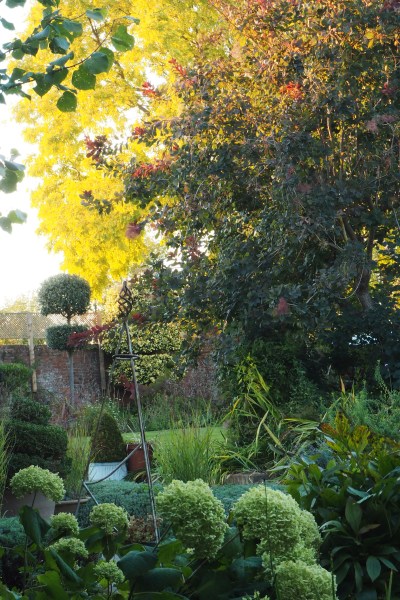
Trees in my garden. I love them, the birds love them, and they are wonderful carbon sinks as we are in the middle of a town.
A tree in front of a house wall can provide up to 25% insulation for the house when it’s in leaf.
Even the smallest garden looks better with a tree. But check how high it will grow and be prepared to have it pruned into shape every so often. The right pruning can also maximise the amount of light that comes through – find out more in how to prune your trees for privacy AND light.
With all the house-building going on at the moment, individual trees are being felled. Each one may not seem like a great loss, but it is still a loss. Collectively, all the trees felled in any one town adds up to a significant deterioration in air quality.
When you plant a tree, make sure that the trunk is above the soil. The part where the root meets the trunk needs to be level with the soil or just a tiny bit above. If you bury the tree trunk in the soil, the tree is ultimately likely to fail, according to award-winning garden designer, Jamie Butterworth. See his tree planting advice here.
Use environmentally-friendly pest control
The disadvantage of using chemical controls to kill off pests is that it often affects beneficial insects too.
I use organically certified slug pellets made of ferric phosphate, such as Sluggo. Some people think that even these could damage other wildlife, although I have seen the Sluggo rep actually eating his own pellets at a garden show.
I also wash aphids off the roses by using washing up liquid. I usually found that this was only necessary up to June as by late summer the ladybirds get on top of the aphid population.
You’re supposed to pick lavender beetle, lily beetle, viburnum beetle etc off by hand and squash them.
Award-winning head gardener and garden consultant Steve Edney runs all his gardens organically. They have been visited by tens of thousands of people, so the borders have to look good at all times. His tips on keeping dahlias free of slugs, snails and earwigs apply to all other garden plants, too.
There are more environmentally friendly pest control suggestions in Slug Resistant Plants – the Easy Way to Beat Slug and Snails in the Garden.
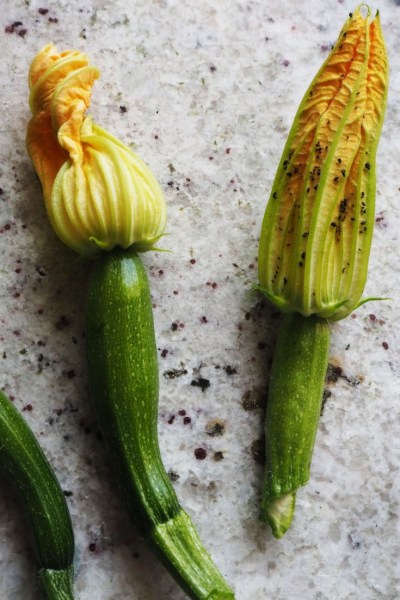
The courgette on the left was grown with nasturtiums, but the one on the right was in a different part of the garden. I was quite surprised to see the difference! And other courgettes from the same plants were similar.
Companion planting is worth trying. Last summer I had some courgettes growing with nasturtiums and others without. The courgettes grown with the nasturtiums had noticeably fewer aphids. Thompson & Morgan have an interesting guide to companion planting.
Plant pollinator-friendly plants
We’ve all heard about the worldwide bee crisis. And it seems that other pollinating insects, such as garden moths, are also in decline.
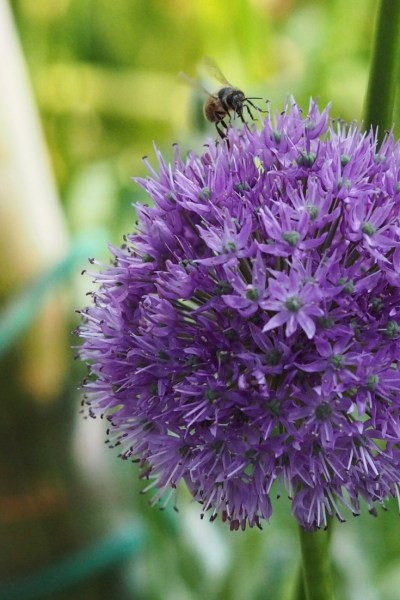
You don’t need meadow flowers to support bees – just make sure your garden has flowers for as long a period as possible, from early snowdrops to late zinnias.
The loss of fields, gardens, plants and flowers is certainly a factor in that decline, so planting pollinator-friendly plants in urban gardens can help.
Fellow blogger Richard Chivers of the Spade Sharp blog has a good post on the decline of bees.
You don’t need to focus on ‘meadow flowers’ to have a pollinator-friendly garden. The important thing is to have flowers blooming in your garden for as much of the year as possible. There are more tips on creating a wildlife friendly garden here from wildlife landscaper Joel Ashton.
Several plant companies have bee-friendly or pollinator-friendly categories. Put ‘bee friendly’ into Suttons Seeds, for example, to get a good selection. Chiltern Seeds have a pollinator-friendly list.
And Friends of the Earth have an excellent guide to bee friendly plants.
Sustainable garden boundaries
Hedges are much better for the environment than fences. The hedges help absorb air pollution and provide habitat and food for wildlife.
There are good tips on how to choose the right hedge for your garden here.
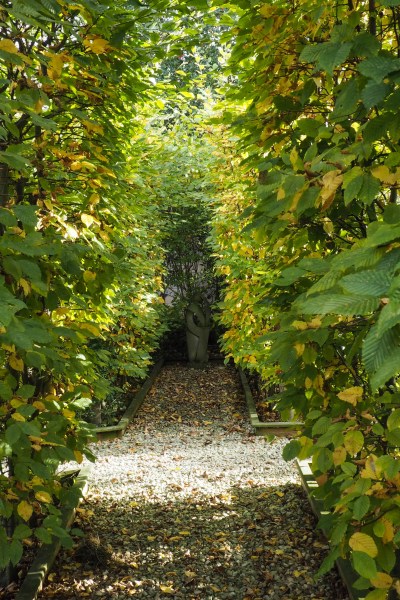
Hedges are better for wildlife and absorb pollution so they are more sustainable than fences. This hedge is in Gardeners World presenter Mark Lane’s garden.
Fences with gravel boards (a solid concrete block at the base) prevent wildlife from moving from garden to garden under the gaps. Hedgehogs in particular need to roam across several gardens.
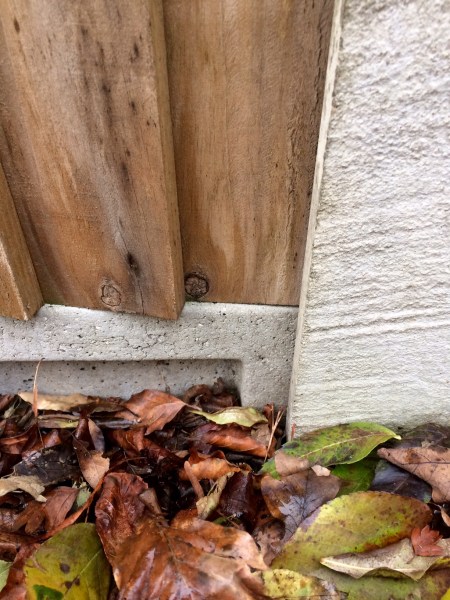
The wooden fence is resting on a concrete ‘gravel board.’ This prevents hedgehogs from moving from garden to garden. Make a small hole in the gravel board to create a wildlife corridor.
If you decide to fence all or part of your garden, then ‘eco-fencing’ is made from FSC certification wood and is treated with products that are not harmful to the environment.
Jackson’s Fencing has a good post on this.
Bat boxes and bug hotels for sustainable gardens
Bat boxes and bug hotels have become fashion accessories in recent years. Make sure yours really do make your garden sustainable and not just gift shop purchases. Find out what they need and where they should be placed.
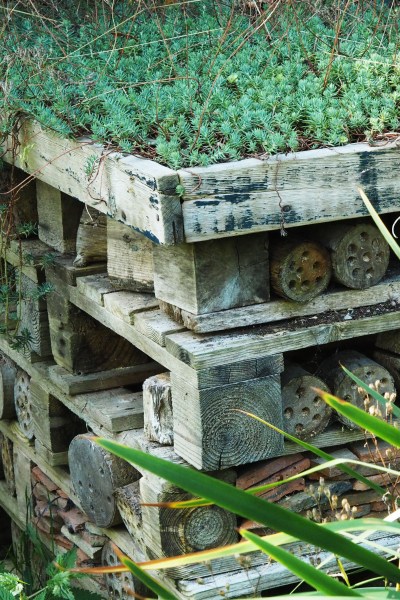
A bug hotel with a green roof at the environmentally-friendly Abbey Physic Garden in Faversham.
Consult the Wildlife Trust on how to build a bat box or bee hotels or Friends of the Earth. And the RSPB have advice on gardening for wildlife. Go to the Bat Conservation Trust for bat boxes – what they are and how to site them.
What else for the sustainable garden?
When you re-design your garden, think about what you can keep that’s there already. This garden with a sense of place kept most of the plants, trees and garden sheds that had been there for years. Yet it feels like a very contemporary garden.
If you want a sustainable garden, it’s also worth asking where seeds and plants come from. How are they transported? What are the working conditions of those growing them? There’s relatively little focus on this aspect of garden sustainability so far. But you can ask…
Sustainable garden tips on video
You can see these sustainable garden tips on video here.
Eco-friendly Middlesized Garden t shirts, hoodies and totes
Although I wouldn’t call myself a fully organic gardener, I try to garden as sustainably as possible. So I’m delighted to say that I’ve partnered with Teemill, who make t-shirts, hoodies and tote bags from natural materials, manufactured using renewable energy. And their packaging is plastic free and recyclable. See the Middlesized Garden Teemill store here.
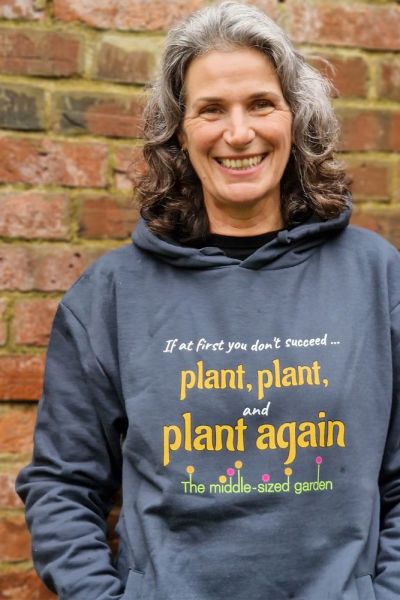
Our niece Irene in the ‘If at first you don’t succeed, plant, plant & plant again’ hoodie. Also available as an organic cotton t-shirt and a tote bag.
More sustainable garden resources
If you wonder whether you can really make a difference in a small garden, here are the questions to ask about ‘green gardening.’
The issue of a sustainable garden ranges across many topics. So rather than looking for books or information ‘on sustainable gardens’ that generally cover a great deal of ground in a superficial way, I would recommend specialist authors, each covering one environmentally-friendly topic in depth.
Sally Nex has written a very comprehensive and easy to understand book called RHS How to Garden the Zero Carbon Way. Sally has also identified what she thinks are the top three things you can do to make your garden more sustainable and eco-friendly here.
For example, sustainable gardening is broadly similar to organic gardening. So I’d strongly recommend Charles Dowding’s books and videos on Organic No Dig Gardening.
Kate Bradbury is an award-winning author and journalist specialising in wildlife-friendly gardening. Her memoir The Bumblebee Flies Anyway records her efforts to reclaim a small urban back garden for nature while gardens around her became increasingly built-up and concreted over. Her latest book is Wildlife Gardening for Everyone and Everything.
And as well as the posts already mentioned, other posts that may be helpful on this blog include What Makes a Good Wildlife Garden, 12 Easy Ways to Help Wildlife in Your Garden Now and How to Make a Mini Wildlife Pond.
Find my favourite sustainable garden products conveniently listed on my ‘Sustainable Garden Products‘ list on the Middlesized Garden Amazon store.
And my Pinterest board Small Wildlife Gardens has more ideas for small and middle-sized gardens.
Do join us every Sunday morning on the Middlesized Garden – fill in the ‘follow by email’ box on the top right of this page!
Pin to remember sustainable garden ideas
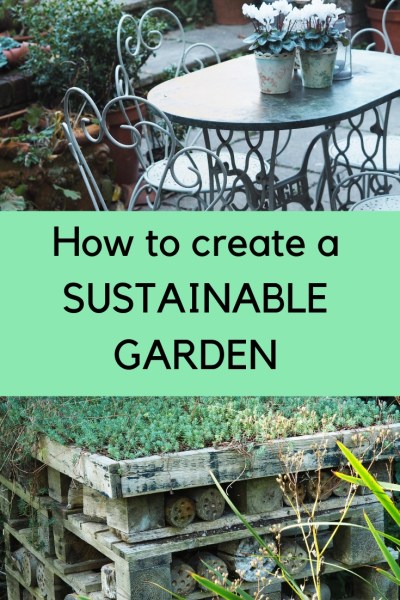
























I think the scientific tests on used coffee grounds as a slug repellent are very variable – it’s not at all clear that it works. But adding coffee grounds to compost wouldn’t break EU law and would be better than adding them to your household waste that goes to landfill.
Absolutely, I agree
I absolutely loved the use of coffee grounds as a natural slug repellant, it seemed to provide the perfect solution; slugs hate it, and eventually it breaks down into wonderful nutrients, sadly, if your plan was too add it as a slug repellant you would technically be break EU law :(
I think the scientific tests on used coffee grounds as a slug repellent are very variable – it’s not at all clear that it works. But adding coffee grounds to compost wouldn’t break EU law and would be better than adding them to your household waste that goes to landfill.
Hi Alexandra,
Reasonable point :) Call it anecdotal then! Lovely article by the way!
Thank you!
We’ve been taking part in the Kent Wildlife Trusts ‘Wild About Gardens’ scheme for the past couple of years – https://www.kentwildlifetrust.org.uk/get-involved/wild-about-gardens . It’s free (although a donation to the trust to support their work is obviously welcome) and involves a visit from an expert volunteer to assess your garden and give advice on what else you can do. Highly recommended.
That’s very good advice, and I think people living in other parts of the UK may have similar schemes with their wildlife trusts, too.